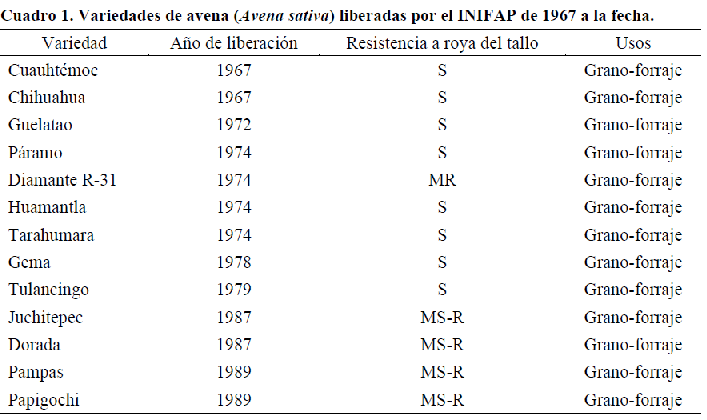Genetic improvement of oats in Mexico
DOI:
https://doi.org/10.29312/remexca.v12i25.2808Keywords:
Avena sativa L., plant breeding, varietiesAbstract
With the creation of the National
Institute of Agricultural Research (INIA), genetic improvement of oats begins in Mexico in the now E xperimental Field Valle de México (CEVAMEX). It began
with the introduction of germplasm from the USA and Canada, in 1962 the first crosses were made and in 1967 varieties (Chihuahua and Cuauhtémoc) were released. In the 60s to 80s segregation rotation in various environments was implemented , obtaining two selection cycles per year, the gravimetric mas s selection method and the establishment of performance t rials in contrasting environments. Currently the National Institute of Forestry, Agricultural and Livestock Research (INIFAP CEVAMEX) turns 61 and has released 33 varieties (18 as INIFAP). From
1985 to 2019 the s own area of oats has increased from approximately 400 000 to 900 000 ha, due to the productivity of the current varieties, re cently Turqu esa’ stan ds out, which has exceeded 8 t ha 1 of grain under rainfed conditions, and that in the last 12 years has been sown in 540 000 ha, whic h produced a profit of $1 350 The challenges in the s hort, medium and long term are to incr ease production in rainfed environment , strengthen research in genetic control of stem rust, drought tolerance and nutritional quality of grain, and sow varieties with high nutritional value for human consumption.
Downloads
References
Espitia, R. E.; Villaseñor, M. H. E.; Tovar, R.; Pérez, P. y Limón, A. 2002. Momento óptimo de corte y comparación de genotipos de avena forrajera. In: Memoria del XIX Congreso Nacional de Fitogenética. Saltillo, Coahuila, México. 282 p.
Jiménez, G. C. A. 1978. Avena. In: Cervantes, S. T. (Ed.). Recursos genéticos disponibles en México. Sociedad Mexicana de Fitogenética. Chapingo, Estado de México, México. 103-110 pp.
Jiménez, G. C. A. 1992. Descripción de variedades de avena cultivadas en México. SARH, INIFAP, CIRCE, CEVAMEX. Chapingo, Estado de México, México. Folleto técnico núm. 3. 72 p.
Leyva, M. S. G.; Espitia, R. E.; Villaseñor, M. H. E. y Huerta-Espino, J. 2004. Pérdidas ocasionadas por Puccinia graminis f. sp. Avenae, causante de la roya del tallo en seis variedades de avena (Avena sativa L.) en los Valles Altos de México. Rev. Mex. Fitopatol. 22(2):166-171.
Mariscal, A. L. A.; Huerta, E. J.; Villaseñor, M. H. E.; Leyva, M. S. G.; Sandoval, I. J. S. y Benítez R. I. 2011. Selección de genotipos de avena para la identificación de razas de roya del tallo. Rev. Mex. Cienc. Agric. 2(4):593-600.
Torres, P. I.; González, C. M. M.; Villaseñor, M. H. E.; Huerta, E. J.; Villordo, P. E.; Espitia, R. E.; Guevara, G. G. y Guevara, O. L. 2007. Marcadores genéticos de resistencia a roya de tallo (Puccinia graminis f. sp. avenae) en avena (Avena sativa L. Agric. Téc. Méx. 33(3):221-230.
Villaseñor, M. H. E.; Huerta-Espino, J.; Rodríguez, G. M. F.; Hortelano, S. R. R.; Martínez, C. E. y Espitia, R. E. 2009. Programa nacional de mejoramiento genético de avena en México: Reseña histórica 66 años al servicio de México 1943-2009. Campo Experimental Valle de México. Publicación especial. 1(1):33-43.

Downloads
Published
How to Cite
Issue
Section
License
Copyright (c) 2021 Revista Mexicana de Ciencias Agrícolas

This work is licensed under a Creative Commons Attribution-NonCommercial 4.0 International License.
The authors who publish in Revista Mexicana de Ciencias Agrícolas accept the following conditions:
In accordance with copyright laws, Revista Mexicana de Ciencias Agrícolas recognizes and respects the authors’ moral right and ownership of property rights which will be transferred to the journal for dissemination in open access. Invariably, all the authors have to sign a letter of transfer of property rights and of originality of the article to Instituto Nacional de Investigaciones Forestales, Agrícolas y Pecuarias (INIFAP) [National Institute of Forestry, Agricultural and Livestock Research]. The author(s) must pay a fee for the reception of articles before proceeding to editorial review.
All the texts published by Revista Mexicana de Ciencias Agrícolas —with no exception— are distributed under a Creative Commons License Attribution-NonCommercial 4.0 International (CC BY-NC 4.0), which allows third parties to use the publication as long as the work’s authorship and its first publication in this journal are mentioned.
The author(s) can enter into independent and additional contractual agreements for the nonexclusive distribution of the version of the article published in Revista Mexicana de Ciencias Agrícolas (for example include it into an institutional repository or publish it in a book) as long as it is clearly and explicitly indicated that the work was published for the first time in Revista Mexicana de Ciencias Agrícolas.
For all the above, the authors shall send the Letter-transfer of Property Rights for the first publication duly filled in and signed by the author(s). This form must be sent as a PDF file to: revista_atm@yahoo.com.mx; cienciasagricola@inifap.gob.mx; remexca2017@gmail.
This work is licensed under a Creative Commons Attribution-Noncommercial 4.0 International license.


